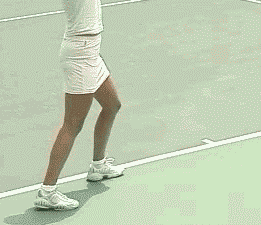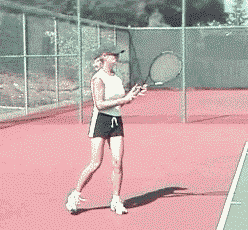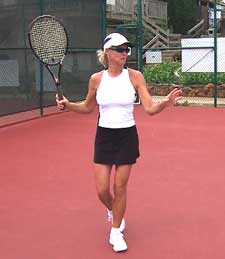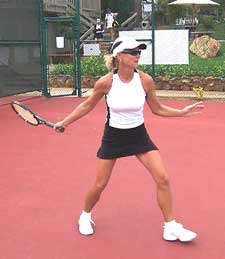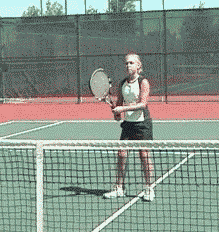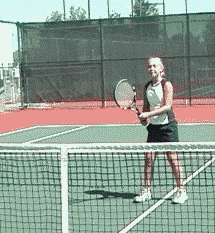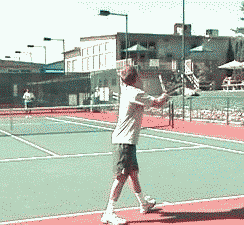|
TennisOne Lessons
Reference Points: The Art of Self-Coaching
by Monty Basnyat During a match, have you ever found yourself in a state of frustration and anger because your favorite shot, you know, that forehand drive you hit so well in practice, has completely deserted you? And it keeps getting worse, so that your blood rushes all the way up to your head making you so tense you can barely move your feet at all.
What is Self-coaching? Self-coaching is the ability to figure out what is going right or wrong on the court during a particular match. Why a stroke breaks down and how to make the necessary adjustments to get back that feeling of smoothness and confidence when it does.
So one minute you're pounding out smooth, deep groundstrokes from corner to corner and the next you're like a beginner playing with a wooden racquet, clumsy, lead footed, and without a clue in the world. Due to an injury to her left foot, she looses rhythm on her serve because she either forgets or is unable to push up with that foot. This left foot push off is the beginning of a kinetic chain that allows her to crank out 110 mph serves on a consistent basis. It's the reference point she refers to when she needs to quickly right her serve.
Developing Reference PointsNo one knows your game better than your do, unless you are among the fortunate who can retain a full time coach. And how often do you see that at the club level? The only person you can depend on is yourself. The sooner you understand this and start becoming more self-reliant, the quicker you will begin playing better tennis on a consistent basis.
It may take two or three days of practice time before you reach enlightenment but when you do, try to memorize that feel. Think about what you are doing and why you are hitting the ball so well. Then, take a moment and jot it down. Case in Point 1 - PamPam is a ferocious competitor at the 3.5 level and an avid tournament and league participant. Pam refers to "Racquet down," as her reference point when her forehand abandons her. Her set up is the cause. On her drive, Pam likes to take her racquet back the traditional way - no loop. Under stress she gets confused between her drive set up (straight back) and her slice set up (racquet head up) and as a result doesn't get under the ball enough. When that happens, she tends to dump the ball into the net. Her reference point is usually enough to straighten her out. Without it, she would often grope in the dark hunting for an answer. More often than not, the result would be anger and frustration rather than any positive outcome. When One is Not EnoughMany players have more than one reference point for a stroke. One reference point may help them get more power while another may help them get more depth or spin. The best way to figure out which reference point to use first is through trial and error. Let's say you have 3 reference points on your backhand. During practice, when your balls begin falling short, take an orderly approach. If your first reference point doesn't fix the problem, move on to the second or third. Remember when your stroke abandons you, the cause is almost always the same. Use the reference points you've worked on in practice and that smooth feeling stroke will most likely return.
Write it DownEveryone has different reference points. Write yours down using a one or two word description as a reminder. It's not beneficial for you to write two paragraphs describing your reference point. When someone reads your points, it does not need to make sense to them as long as it makes sense to you. Stay positive with your points, don't start the sentence with don't or can't. Case in Point 2 - EmileeEmilee is a 13 year old nationally ranked junior. When her backhand isn't working, she refers to one of the following reference points to get it back:
It may not make sense to you, but for Emilee, it makes a world of difference. By focusing on one of the three points, she is usually able to reestablish her rhythm and timing.
Embedding Reference PointsOnce you have your reference points down, the way to embed them into your game is through discipline. Keep a copy of your points in your tennis bag and the next time your stroke goes awry, take a quick peek during the change over. Do this enough times, you will quickly internalize them and routinely begin using them. Case in Point 3 - HeatherHeather is a competitive junior player who likes to play at the net. She has decent volleys for a 12 year old girl, however, Heather has a tendency to become to wristy which causes her to shank or spray her volley's. The problem occurs because she brings her racquet head up too high, starting from her ear and finishing down around her ankle. It's this chopping motion and the wrist action that causes her problems. Heather's reference point is - "no wrist." Referring to it reminds her to smooth out her set up and stop bringing the racquet head up too high. When she stops this, she quits using the wrist and starts hitting solid volleys. Case in Point 4 - ColeCole, a top collegiate player is an aggressive net rusher like a Tim Henman or a Patrick Rafter. Under stress, Cole, tends to rush. He is in too much of a hurry to get to the net and therefore forgets to time his split step. By slowing down and timing the split, he tends to watch the ball as it bounces up on the other side of the net and finds himself more balanced and able to execute better volleys. He has two reference points to help control this tendency.
Reference Points - Change the Strategy Not the StyleReference points can be used to maintain focus on your overall game also. It can be especially effective when your execution is off. During his first two service games Cole was slicing his serve out wide to the deuce court and rushing the net. The purpose was to pull his opponent's momentum out wide leaving an open court for him to volley into. An effective strategy that earned him a couple of round wins in the tournament but this particular was reading his serve and returning exceptionally well. So rather than abandoning his style of play, Cole used his reference points to mak an adjustment.
Cole changed his strategy by mixing up his serves a little bit, slicing it into the body or placing it down the middle more. A few times, he chose to come in behind the return as opposed to the serve. This may sound simple but, during the heat of battle, many players, under similar conditions will abandon their style of play and camp out at the baseline. A style they are not really comfortable with. Changing style is like an admission that you can't win so the alternative is to hope your opponent loses. Should you ever change your style during a match? Yes, but only when you have exhausted all your tactics. In effect, you have thrown the kitchen sink at your opponent and nothing is working. The match is slipping away so it may be time to try something else, anything. But barring this, do what you do best and let the chips fall where they may. Your comments are welcome. Let us know what you think about Monty Basnyat's article by emailing us here at TennisONE. |
||||||||||||||

